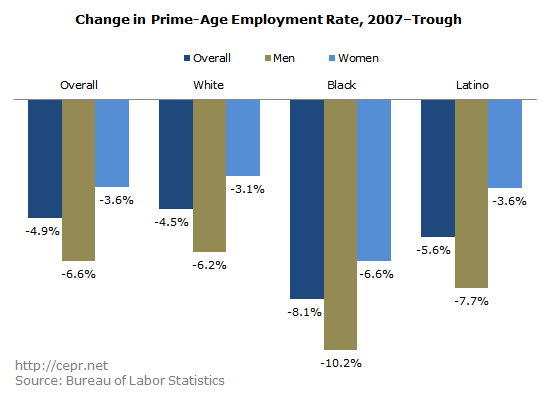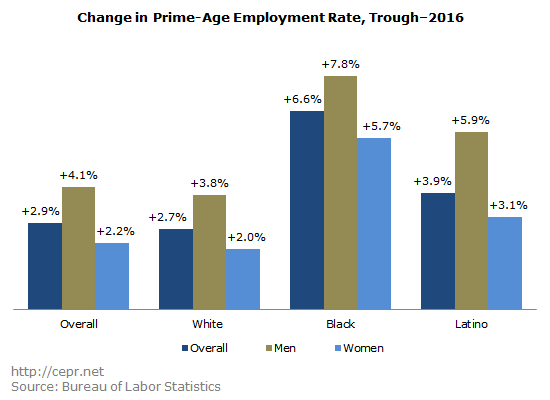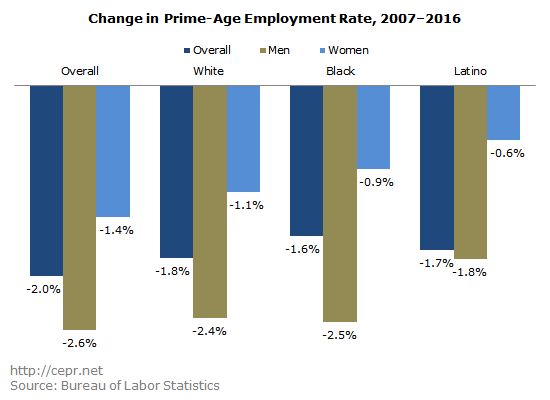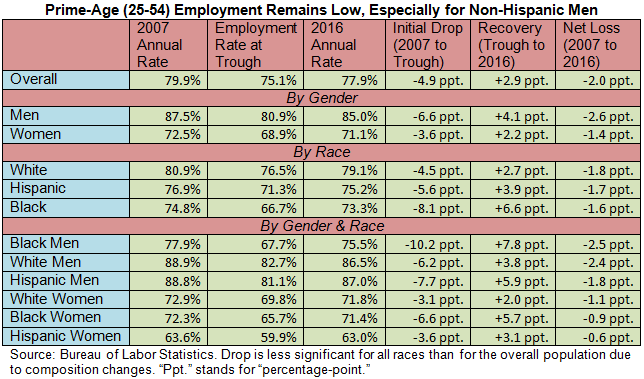Article
Fact-based, data-driven research and analysis to advance democratic debate on vital issues shaping people’s lives.
Center for Economic and Policy Research
1611 Connecticut Ave. NW
Suite 400
Washington, DC 20009
Tel: 202-293-5380
Fax: 202-588-1356
https://cepr.net
In October of 2009, the national unemployment rate peaked at 10 percent; as of December 2016, it was down to 4.7 percent. The Federal Reserve Board voted last month to raise interest rates in part due to this low rate, and the decrease in unemployment has generally been hailed as a sign of recovery. But how accurately do those numbers reflect the current employment situation for most workers? This post looks at prime-age employment rates for several different demographic groups to create a clearer picture of how the recession and recovery affected American workers.
The unemployment rate only includes workers who have been actively seeking jobs during the last four weeks. However, due to the severity and duration of the most recent recession, many prospective workers simply gave up looking and were not counted in the unemployment rate. To account for these “missing workers”, this post analyzes the employment rate instead of the unemployment rate. By using the prime-age employment rate – the employment rate for workers ages 25 to 54 – it avoids any bias attributable to the aging of the population.
Finally, we break down the results by gender and race in order to see which demographic groups lost the most jobs during the recession. Because data are not available on a seasonally adjusted basis for most of these measures, we use 12-month averages of the not-seasonally-adjusted data.
The Loss in Employment
Overall, the decrease in prime-age employment from 2007 to the lowest employment point was 4.9 percentage-points. That breaks down to a 3.6 percentage-point loss for women and a much greater 6.6 percentage-point loss for men. Employment decreased less for white workers than for black and Latino workers, with black workers experiencing almost double the loss (8.1 percentage-points) of white workers (4.5 percentage-points). White female workers experienced a decline only half as large as that of white male workers, and overall experienced the smallest decrease in employment of any demographic group. The recession was longest for white female workers though, with the employment rate declining through August of 2012 (the decline for white men ended in July 2010). For black workers, the recession ended about the same time for males and females, although again the decline was much greater for men than for women. Black women lost more employment than white or Latino women, and had the third greatest job loss of any group. Black men experienced the most drastic loss of employment overall, dropping 10.2 percentage-points from 2007 to October 2011. Latino men lost almost twice as much employment as Latino women; however, they hit their employment trough in May 2010 and thus saw their employment rate begin recovering earlier than any other group.

For both genders, black workers saw the largest drop in employment between 2007 and the low point during the past decade. In each racial or ethnic group, men experienced far more significant declines in employment than women. The period of declining employment was shortest in duration for Latino men and was longest for white women.
The Incomplete Recovery
Overall there has been a 2.9 percentage-point increase in employment since February of 2010; this means that the labor market is about 60 percent recovered from the recession. Male workers have experienced a greater percentage-point increase in employment than female workers, but their initial drop was also greater. Prime-age employment rates for both men and women are about 60 percent recovered. White workers follow the same trend as the overall recovery, with white women having regained slightly more of their lost employment than white men. Black workers, after experiencing the sharpest drop in employment, have also had the greatest recovery, with black male workers seeing a 7.8 percentage-point increase in employment since October 2011. Black women have recovered almost 87 percent of their former employment, the most significant degree of recovery for any demographic. Employment is up 5.9 percentage-points for Hispanic men and 3.1 percentage-points for Hispanic women relative to their troughs following the recession.

Although they experienced a less extreme recession, white workers are experiencing a slower recovery. Black workers, especially black women, have experienced the most significant recovery.
The Net Loss in Employment (2007-2016)
Overall, the net employment loss since 2007 has been 2 percentage-points. And while the loss hasn’t been even across demographic groups, no group has yet to fully recover. Relative to 2007, employment is still down 1.4 percentage-points among prime-age women and 2.6 percentage-points among prime-age men. While black workers initially experienced the largest decrease in employment, they have also experienced the strongest recovery. Prime-age employment is now down almost equally for blacks and whites. The gender disparity, however, is still very large. In every case the employment loss for female workers was less than half that of male workers. White and black men seem to have been hit the hardest, with white men still 2.4 percentage-points below their 2007 employment rate and black men experiencing a slightly larger 2.5 percentage-point loss. Prime-age employment is down almost 0.6 percentage-points among Hispanic women and about 1.8 percentage-points among Hispanic men.

In general, employment is still down the most for black and white men. The loss of employment for prime-age black men is especially notable given that black men were less likely to be employed than white or Latino men even before the recession:

Although unemployment is low, prime-age employment numbers illustrate that America’s workers still have not recovered from the recession. For men in particular, the unemployment figures do not give a complete picture of the number of people out of work.